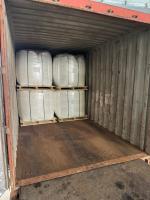ultra high charge of cationic polyacrylamide (zetag 8180 zetag8185 zetag 8187)can be replaced by Chinafloc -AC
zetag 8180 zetag8185 zetag 8187 are three cationic polyacrylamide with ultra high charge(80-90%),mainly used for water treatment ,sludge dewatering,agriculture ,papr making and other applications.chinafloc --AC series of cationic polyacrylamide can replace of them with very good performance.
Cationic flocculants with an 80% charge are specialized chemicals used primarily in the treatment of water and wastewater, among other applications. These flocculants, due to their high charge density, are particularly effective in processes where rapid settling of suspended particles is required. In this detailed examination, we'll explore the main applications of these chemicals, focusing on their role in water treatment, sludge dewatering, paper production, oil and gas operations, and agriculture. The effectiveness of cationic flocculants in these areas demonstrates their importance in both industrial and environmental contexts.
Water Treatment
In the context of water treatment, cationic flocculants play a crucial role in the coagulation and flocculation process, which is a critical step in the purification of drinking water as well as the treatment of industrial and municipal wastewater. The 80% charge of these flocculants allows them to neutralize the negatively charged particles found in water, such as silts, clays, organic matter, and certain types of bacteria and viruses, effectively aggregating them into larger flocs. These flocs can then be easily removed through sedimentation, flotation, or filtration processes. The high charge density of these flocculants enhances their ability to work efficiently across a wide range of pH levels and turbidity conditions, making them particularly versatile in treating diverse water qualities.
Sludge Dewatering
Sludge dewatering is another critical application where the high charge density of cationic flocculants proves invaluable. In the treatment of municipal and industrial wastewater, the generation of sludge is an unavoidable by-product. The process of dewatering seeks to reduce the volume of this sludge, thereby making its disposal more economical and environmentally friendly. Cationic flocculants with an 80% charge are effective in separating the water content from the solid components of sludge, significantly enhancing the efficiency of dewatering equipment such as belt press filters, centrifuges, and screw presses. Their high charge density facilitates the rapid formation of robust flocs that are less prone to shearing, resulting in a drier cake and clearer filtrate.
Paper Production
In the paper manufacturing industry, cationic flocculants are used to improve the retention of fines and fillers, enhance drainage, and facilitate the formation of the paper sheet. The 80% charge density of these flocculants ensures a strong interaction with negatively charged fibers and fillers, thereby improving the mechanical properties of paper, reducing the consumption of raw materials and energy, and minimizing the environmental impact of the production process. Additionally, the use of cationic flocculants can lead to improvements in the clarity and quality of the process water, which can be recycled and reused, further contributing to environmental sustainability.
Oil and Gas Operations
In oil and gas operations, particularly in the drilling and extraction processes, cationic flocculants are used for water treatment, drilling mud conditioning, and enhancing oil recovery. The high charge density makes them effective in separating oil and water emulsions, treating produced water for reuse or disposal, and improving the efficiency of drilling operations by conditioning the drilling mud. This not only ensures the operational efficiency but also helps in minimizing the environmental footprint of oil and gas extraction activities.
Agriculture
Lastly, the use of cationic flocculants in agriculture, although less common, has shown promise in improving soil structure, increasing water retention, and enhancing nutrient delivery to plants. The high charge density can help in aggregating fine soil particles into larger structures, which can improve the aeration and water-holding capacity of the soil, potentially leading to increased crop yields.

